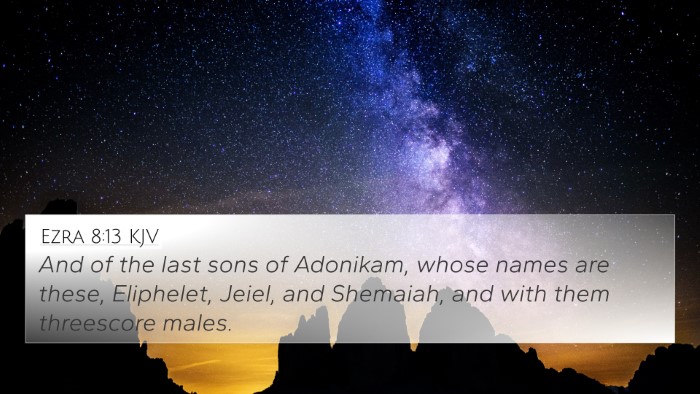Understanding Ezra 2:13
Ezra 2:13 provides a list of the descendants of the priests returning to Jerusalem after the Babylonian exile. Specifically, it mentions the sons of Adin, who numbered 666. This number is significant, as it reflects the community's strength and dedication to restoring their religious practices in their homeland.
Verse Context and Historical Background
The verse is part of a larger narrative detailing the return of the exiles from Babylon to Jerusalem, as recorded in the book of Ezra. This return marks a pivotal moment in Jewish history as it represents the restoration of God's people and the rebuilding of the temple.
Commentary Insights
- Matthew Henry:
Matthew Henry emphasizes the importance of listing those who returned. This not only serves historical documentation but also demonstrates the faithfulness of God in keeping His promises to bring His people back. The mention of the number 666 can be seen as a reminder of the trials faced, but it also indicates a remnant that is hopeful and faithful.
- Albert Barnes:
Albert Barnes remarks on the sons of Adin, highlighting that the name signifies "swift" and indicates a lineage that is quick to respond to God’s call for return. Barnes points out that the specific number reflects a calculated effort by the returning exiles to reestablish their identities as God's chosen people and their roles in the religious community.
- Adam Clarke:
Adam Clarke further discusses the symbolism of the number 666, suggesting that it might allude to a period of oppression as it is often associated with the adversary in Biblical numerology. Clarke posits that the return of this group signals a move away from their previous trials and a step towards redemption and community restoration.
Cross-References for Ezra 2:13
To garner a deeper understanding of Ezra 2:13, one can explore the following cross-references:
- Nehemiah 7:18: This verse parallels the list of names and numbers of those returning, confirming the individuals and their familial ties.
- Ezra 2:1-2: The opening verses provide the initial context of the return and those who led the movement.
- Zechariah 1:17: This verse reflects God's promise of restoration for His people, aligning with the theme of Ezra’s return.
- Jeremiah 29:10: This prophecy discusses the return from Babylon and the restoration of the Jewish people, reinforcing their hope and expectations.
- Isaiah 44:28: Here, God names Cyrus as a shepherd, indicating that He uses leaders for His redemptive purposes.
- Ezra 1:5: Discusses the stirring of the hearts of Jews to return, supporting the idea of a divinely orchestrated return.
- 1 Chronicles 9:1: Lists the families and priests, connecting the history prior to exile to those returning post-exile.
Thematic Connections
- Faithfulness to God's Promises: The return signifies the fulfillment of God's promise to His people, which is a central theme throughout Scripture.
- Community and Identity: The enumeration of families reminds the individuals of their heritage, reinforcing their identity as God's chosen people.
- Restoration and Hope: The act of returning represents not just a physical relocation but a spiritual renewal, highlighting God's grace and restoration.
Conclusion
Ezra 2:13, while seemingly just a list of names and numbers, encapsulates profound themes of hope, restoration, and the faithfulness of God to His people. It encourages us to reflect on the significance of community and identity in our spiritual journey. Through the encouragement of cross-referencing other scriptures, we can see a broader narrative of God's interaction with His people, strengthening our understanding of His Word.




